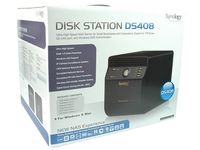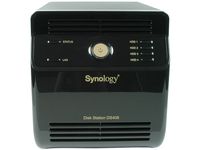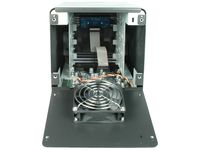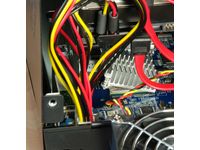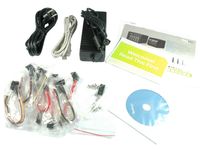Synology's DS408 Reviewed: Fast NAS For Pros
Synology Disk Station DS408
The Synology DS408 is available in online shops for about $750 without hard drives. Purchasing an empty housing makes sense especially if you still have unused hard drives from a computer upgrade that you want to put to good use.
Although you can find the DS408 pre-configured through a number of VARs, we’re still going to recommend going for the empty enclosure and building up your own configuration that best meets your storage and expansion needs.
Build
Although purchasing a Disk Station DS408 is expensive, you will get a very nicely-built device for this price with a very good data transfer rate in comparison to other devices in this price class. More about this later.
The housing of the DS408 NAS devices is almost completely constructed of metal. Only the front is made out of glossy, black plastic, which doesn’t lower the overall impression. In contrast to other devices, the hard drives are installed into the DS408 by opening the back, and there are no movable plastic parts that might break off. The front is simple, functional, and gives information about the status of the individual hard drives, LAN activity and the device as a whole.
One negative is that you cannot use slide-out trays to install the hard drives in the DS408, which in this price class is pretty much standard. The hard drives are mounted in the device with screws, which means switching out a defective hard drive is a lot of work.
The back of the DS408 housing has a hinge and can be flipped open after removing four thumb screws. Once the rear of the DS408 is open, you have to remove the rest of the housing in order to install the hard drives.
Get Tom's Hardware's best news and in-depth reviews, straight to your inbox.
After the hard drives are installed into the hard drive cage, you simply put the housing back together. The precision of the fit is very good, though connecting the single SATA power and data cables in this tight space is a real mess. Closing the case also requires attention and dexterous fingers. The 80 mm fan on the back is deep in the housing and when closing the lid, it’s easy to pinch some cables.
We noticed that, after a couple of hours, when we installed an additional hard drive, a passive cooler on the motherboard came loose. We think that the cooler must have come loose in transit. The increase in temperature caused the system to crash—something that should not happen in a storage device priced as high as this one.
Accessories
The Synology Disk Station DS408 comes with more bundled accessories than other NAS devices. This is not so much due to the generosity of the manufacturer, but rather because of how the hard drives are installed. This is the reason why there are four additional SATA power and data cables in the accessories, as well as the external power supply, an Ethernet network cable, a manual, and quick-start instructions. In an enclosure with a midplane, the cabling wouldn’t be necessary at all.
Don’t forget the CD, which contains the Synology Assistant application, as well as a copy of the firmware for the NAS device.
Current page: Synology Disk Station DS408
Prev Page Introduction Next Page Technical Data And Features-
slomo4sho Wouldn't a HTPC style server with raid configured terabyte drives provide similar or better performance for a fraction of the cost? I mean the most expensive component in such a setup would be the dual LAN motherboard...Reply -
VTOLfreak You don't even need a dual lan mobo. Just stick an extra NIC into a PCIe slot. (Or PCI)Reply
And you are right, a homebuilt server running some flavor of Linux would be faster and cheaper. You'd also be able to ditch your router and use the server as router aswell.
The downside is ofcourse is that its a DIY job. You need to assemble the hardware yourself, then install and configure the whole thing. For some people thay may be a major problem. -
Actually VTOLfreak has a good point. A homebuilt server would cost about the same and completely kill this thing performance wise. Granted you'd would need to Do-It-Yourself but I would hope most Tom's readers are already DIY type. :D I should also point out that the QNAP NAS's are only slightly slower and the Linux community has already hacked / ported a version of Debian Linux in testing to it. It's what I plan on doing with my QNAP NAS to release it's full functionality. Here's the website: http://www.cyrius.com/debian/orion/qnap/Reply
-
malveaux Heya,Reply
NAS will never match a computer with the disks in the box over a network's performance. NAS is simple. This NAS box they're talking about is an expensive "computer" with no hardware. You could get a cheap motherboard/CPU/RAM/Case for like $200 bare bones (you don't need a dualcore for this; hence most folk at home with NAS just converted an old computer into one) and just toss in some drives and you're set so long as you have a gigabit lan card installed. All cheap. Install FREENAS and put the thing in a closet or wherever and forget it.
These expensive empty NAS chasis are essentially for small businesses that want it to be absolutely simplistic and don't mind overpaying for something their IT guy could build for cheaper and likely more reliable.
Cheers, -
malveaux My god, $750?Reply
Mobo with onboard video and onboard RAID5 and gigabit LAN at newegg: $150
AMD5000+ retail $60 at newegg
RAM, 2gigs DDR2 800 $50 at newegg
Case with 300~400watt PSU, $50 at newegg
WD 640g 7200rpm drive $75 at newegg
FreeNAS - Free at freenas.org
$310 for the system and the OS.
Get 5 WD 640g 7200rpm drives @ $75 each, for $375
Configure in a RAID5 setup: 2.5 tb of storage with parity against a drive fail.
$685.
Still cheaper than that "pro" nas thing. Faster. And it has potential to be added to beyond it's limited walls unlike that "pro" nas box there.
Cheers, -
zak_mckraken I've been looking around for a NAS solution myself and I still can't decide what would be the best for me. So far I've been looking at that setup:Reply
Chenbro ES34069 + riser card : 240,00 $
Intel D945GCLF2 + Atom Dual Core 1.6ghz : 103,08 $
Kingston 2go KVR667D2N5K2/2G : 36,15 $
Promise Fasttrak TX4310 Raid 5 : 149,04 $
Seagate 500go ST3500320AS X3 : 228,54$ (76,18 $ each)
Total : 756,81 $
BTW, these prices are in candadian dollars. What really raises the bill are the raid card and the case. I've been looking for a Mini-ITX mainly for the fun of building such a small PC but I'm not sure if it's worth the price yet. It will also take less space and consume less power than a normal PC but then again is it worth paying over 200$ more?
I'm also worried about Raid 5 performance. With such a setup, I would have 1tb of data in Raid 5 on a gigabit LAN. My initial plan is to replace (not just backup) my multimedia files on my computer and mapmy personal folder directly to the NAS. This way, I would have more space on my computer and the files would also be available to stream from my 360. Do you think such a setup would be seamless for my computer or will I experience some lag with the mapped folders? -
daft malveauxMy god, $750?Mobo with onboard video and onboard RAID5 and gigabit LAN at newegg: $150AMD5000+ retail $60 at neweggRAM, 2gigs DDR2 800 $50 at neweggCase with 300~400watt PSU, $50 at neweggWD 640g 7200rpm drive $75 at neweggFreeNAS - Free at freenas.org$310 for the system and the OS.Get 5 WD 640g 7200rpm drives @ $75 each, for $375Configure in a RAID5 setup: 2.5 tb of storage with parity against a drive fail.$685.Still cheaper than that "pro" nas thing. Faster. And it has potential to be added to beyond it's limited walls unlike that "pro" nas box there.Cheers,Reply
its a NAS, it doesn't need that high end of a mobo
(all parts newegg)
cpu: AMD x2 5000+ $59
mobo: Foxconn A74MX-K $50
Case: Linkworld PRESCOTT 437-01-C2222 Black SECC/SGCC MicroATX Mid Tower Computer 430 watt PSU $33
Ram: OCZ OCZ2VU8002GK 2x1GB ddr2 800 $24
NIC: Zonet 10/100 (not everyone has 100+ Mb internet access)$10
HDD: 4X SAMSUNG HD103UI 1TB 5400 RPM $99 each $396 total
3x molex to sata cable $3 each $6.87 total (savings)
total $578.79 with shipping $609.32
-
snarfies1 So far every NAS I've ever seen falls into one of two categories - crap that doesn't work well/right, and/or insanely expensive. The first company who comes up with a solution that doesn't fall into either category will have my money. Until then, do not want.Reply -
doittoit I struggled with this for months. Here's what I did and why:Reply
I already had an old northwood 3.0 and raid capable motherboard for which I found a new bios for that supported raid 5. The board has a GB ethernet NIC integral to it. I started out buying a case ($59, 7 x 3 1/2" internal, 5 x 5 1/4" external) and a tagan 700W single 12v rail PS ($80). I bought 3 x samsung spinpoint F1 750 GB sata II ($99 ea). Put xp on it, built the array with a stripe size of 32k. 15 MB/s write, 50 MB/s read. Pathetic!! Pulled out a drive, formatted it on another PC, and stuck it back in for a rebuild of the ~1.4 TB array. After running for 4 days and not completing, I pulled the plug.
Phase 2 additions:
Intel DG33TL motherboard ($99). Integrated video, HD audio (digital in, digital out), Intel GBe, ICH9R onboard. Intel e7200 CPU ($99) - 65W TDP, 4 x corsair XMS2 2 GB PC6400 DDR2 ($55 per pair - total $110).
Bought a ocpy of vista64 to address the 8GB ram AND create GPT > 2TB. Bought another samsung spnpoint F1 ( so now 4 x 750 in raid 5) in 1 ~2.1TB volume.
I used passmark to benchmark seq read, seq write, and random access locally. Over 200 MB/s read and write locally. Random access ~10MB/s. I used the same Intel NAS benchmark suite and got over double performance in every single benchmark over the network that the reviewed NAS got. Rebuild of the array takes ~4 hours.
Approximately $850 + OS. Found a hack to put the terminal services DDL from server 2008 on vista64 sp1 so I can have multiple simultaneous users remoted-in. I have MySQL, SQL Server 2005, and SQL Server 2008 installed, antivirus, centralized backup of all PC's on the network to one location.
In my opinion, unless it is REALLY CHEAP, NAS is a waste of money. If you can administer this NAS (raid level, permissions), then you can administer the "server" I describe with the added bonus of being able to use a windows interface. -
falcompsx doittoit If you can administer this NAS (raid level, permissions), then you can administer the "server" I describe with the added bonus of being able to use a windows interface.Reply
not to mention if you buy windows you can let it double as a media center as well. Might need a few upgrades to be HD capable, but it would serve 480P media just fine as is, probably even 720P.
